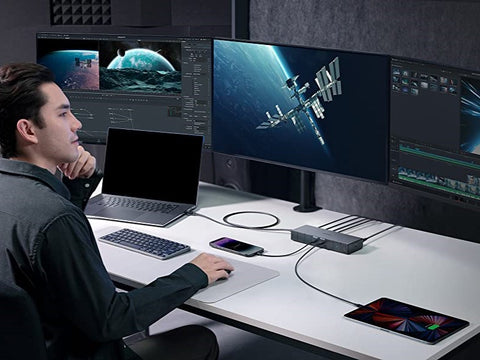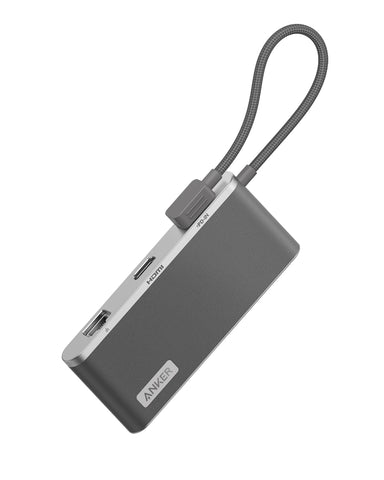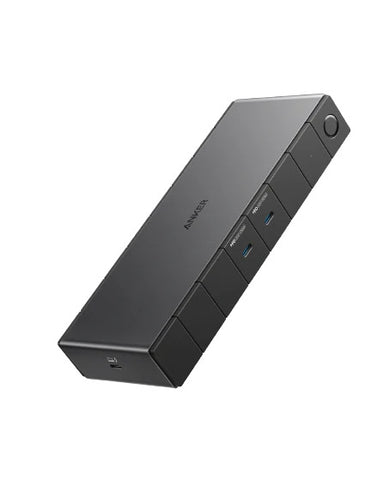
New Horizons: Can USB-C Be Used for Ethernet Access?
Share
Exploring the capabilities of modern technology, one might ask, "Can USB-C be used for Ethernet?" While on the surface, this may seem like an unorthodox question, upon delving deeper into its implications, it becomes evident that this topic could indeed have significant effects. In this article, we will address the uncertainty and provide various methods of connecting USB-C to Ethernet. We will also guide you on selecting the appropriate USB-C to HDMI accessories so that enhancing your tech arsenal will be easy. We will also present a straightforward tutorial on setting up USB-C Ethernet connections. So what are you waiting for? Let's unlock the full potential of your USB-C ports!

Different Ways of Connecting USB-C to Ethernet
There are primarily three popular methods through which you can connect a USB-C device to an Ethernet network. These methods include using:
With Adapters
Can USB-C carry ethernet? Yes, and this can be utilized with an adapter. USB-C to Ethernet adapters are simple, compact, and provide a straightforward solution. These adapters have a USB-C connector on one end and an Ethernet RJ45 connector on the other. To use such an adapter, connect the USB-C end to your device, and the Ethernet cable to the RJ45 end. These adapters are typically plug-and-play and do not require any additional software and/or drivers to function correctly.
With Hubs
USB-C hubs differ from adapters by offering multiple types of connections, not just Ethernet. Hubs usually feature a mix of USB-A, USB-C, HDMI, and Ethernet ports. To use a hub, connect it to your device using the USB-C port and then plug the Ethernet cable into the appropriate socket on the hub. USB-C hubs are advantageous because they turn a single USB-C connection into multiple connections, allowing you to connect several devices simultaneously.
Looking for a great hub?Check out the Anker 655 USB-C Hub (8-in-1)! It is a stylish 8-in-1 hub in Earthy White and Charcoal Gray, with a distinctive faux leather exterior and a braided nylon cable. Offering an impressive 100W USB-C Power Delivery, we've equipped it with two USB-A 3.2 Gen 2 data ports, a 4K HDMI slot, Ethernet, microSD/SD card readers, and even an AUX port. It also promises speedy file transfers and quality 4K@60Hz display mirroring, with transfer speeds up to 10 Gbps (a laptop with a DP 1.4 port is required).
{{ component: "product", handle: "a8382", sku: "A8382021"}}
With Docking Stations
Docking stations act as a more robust, usually desktop-bound, hub, offering a wide array of connections including Ethernet. Docking stations are designed for users that require a lot of connectivity options or have more complex setups involving multiple monitors and peripherals. To connect via a docking station, plug it into your device using the USB-C connector, and then connect the Ethernet cable to the dock. These docks allow you to seamlessly switch between Ethernet and Wi-Fi, depending on your needs.
Meet our Anker 778 Thunderbolt Docking Station, your ideal 12-in-1 docking solution! Packed with high-speed connections, including Thunderbolt 4, USB-C, and 8K HDMI 2.1, we've designed it to elevate your connectivity game. Experience up to 40 Gbps of upstream bandwidth, letting you connect to a stunning 8K display or even four 4K displays simultaneously. And we haven't forgotten about power – charge your laptop up to 100W and other devices at 30W via the USB-C ports. Just note that this product is not compatible with M1/M2 MacBooks or Asus laptops with AMD CPU.
{{ component: "product", handle: "a83a9", sku: "A83A91A1"}}
What to look for when choosing a USB-C to HDMI accessory?
When looking for USB-C to HDMI accessories, it's crucial to consider certain key factors such as compatibility, quality, and functionality. Here's a guide for each device type:
For Adapters
- Compatibility:Look for an adapter that works with your specific laptop model and operating system. Check if it supports HDMI, 4k, and possibly even 8k.
- Plug & Play:Choose an Adapter that does not require complicated driver installations. The adapter should be ready to use once you plug it in.
- Quality:It should have a solid build and be durable. Also, look for gold plated connectors for better signal transmission.
- Power Delivery: If you're using it over extended periods, look for an adapter with power delivery so you can always charge your device while continuously using it.
For Hubs
- Ports: Look for the number of ports and types (HDMI, USB, SD Card Reader, Ethernet). More ports offer versatility and convenience.
- Power Delivery:A hub that can pass power through to your device will allow you to charge it while using the hub.
- Data Transfer Speed:Look for hubs that support high data transfer speeds, especially if you plan on connecting several devices at once.
- Design & Build:It's essential that the hub is portable, lightweight yet sturdy, given that it will be constantly connected and disconnected.
For Docking Stations
- Connectivity:Docking stations should provide a multitude of connection options including HDMI, USB-C, USB 3.0, Ethernet, and more.
- Power Delivery:A capable docking station should have high charging power for your laptop and other devices.
- Display Compatibility: Make sure the docking station supports multiple monitors if needed and supports the resolution and refresh rates your monitors require.
- Data Transfer Speed: A docking station supporting high-speed data transfer will make your work smooth and faster.
How to Set Up USB-C Ethernet Connections
Follow the steps below to set up a USB-C Ethernet connection:
- Connect the Adapter:Insert the Ethernet cable into an open/available Ethernet port on your modem or router, then connect the other end to your USB-C to Ethernet adapter.
- Connect Adapter to Computer:Connect the USB-C end of the adapter to a free USB-C port on your computer.
- Configure the Connection:On your computer, go to your Control Panel or Settings ➡ Network & Internet ➡ Select the Ethernet connection and ensure it is enabled.
- Test the Connection:Open a web browser and try to access a website to confirm the Ethernet connection works. If not, troubleshoot by checking whether all connections are secure or try restarting your computer.
Conclusion
In wrapping up, the versatility of USB-C continues to surprise many tech enthusiasts. One might wonder, "can USB-C be used for ethernet?" The answer is a resounding yes! Whether it's through adapters, hubs, or docking stations, USB-C provides a seamless way to connect to Ethernet, ensuring stable internet connectivity. As we've explored, while adapters are great for quick connections, hubs and docking stations offer a multitude of additional ports for various needs. So, the next time you're faced with a Wi-Fi dead zone or need a reliable connection for an important video conference, remember that your USB-C port can be your Ethernet lifesaver. Just make sure to pick the right accessory for your needs!
FAQ
Here are some commonly asked questions regarding "Can USB-C be used for ethernet?".
Is USB-C to Ethernet faster?
Does USB-C to Ethernet work? Yes, and the speed between USB-C to Ethernet largely depends on the specifications of the specific USB-C port and the Ethernet standard. Generally, Ethernet connections can offer faster data transfer rates compared to USB-C, especially with Gigabit Ethernet. However, newer versions of USB-C, like USB 3.1 and 3.2, can deliver comparable speed, reaching up to 10 Gbps.
Does USB-C support Gigabit Ethernet?
Does USB-C support Ethernet / Gigabit Ethernet? Yes, USB-C can support Gigabit Ethernet. The adapter, however, needs to be specifically designed to support Gigabit Ethernet. Do note that the ultimate speed will depend upon many factors such as the capabilities of your device, the quality of your cables, and the type of your USB port.
What is the speed limit of USB-C to Ethernet adapter?
The speed limit of a USB-C to Ethernet adapter depends on the specifications of both the USB-C port and the Ethernet standard being used. USB-C supports various data transfer rates ranging from 480 Mbps (USB 2.0) up to 20 Gbps (USB 3.2 Gen 2x2). For Ethernet, speeds can range from 10 Mbps (10Base-T Ethernet) up to 100 Gbps (100 Gigabit Ethernet). An adapter's speed will be limited by the slower of the two technologies.